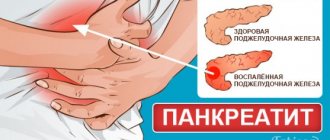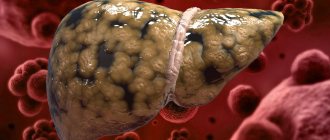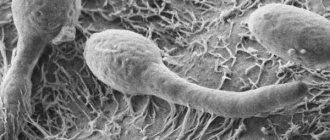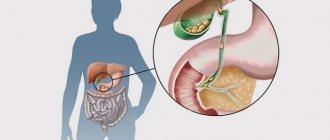Published 01/16/2020 · Comments: · Reading time: 6 min · Views: Post Views: 2,181
You cannot sit idly by and wait for constipation to go away on its own. Long-term retention of stool, in addition to causing psychological inconvenience, causes physical suffering, and causes the development of complications. One of them is fecal stones in the intestines - hard accumulations of compacted fecal matter.
In advanced cases, the only treatment option may be surgery. Who is predisposed to such a problem, how to remove fecal stones at home? We will answer in this article.
How are they formed?
Fecal stone forms in the intestinal flexures. The fact is that once food enters the intestines, it undergoes active absorption processes, carried out thanks to beneficial intestinal microflora.
With severe overeating, microflora disorders and other pathological conditions, the food taken by a person does not have time to be processed, as a result of which a certain amount of feces is retained in the intestinal area . If this happens often, then the intestinal surface is filled with feces, and rotting processes begin to actively develop. The remains of feces themselves gradually become harder, turning into stone formations of oval or round shape.
Please note: The size of fecal stones increases over time and can reach 15 centimeters in diameter!
Classification
Fecal stones, depending on their origin, can be:
- true - if they are formed directly in the large intestine;
- false - penetrate into the intestinal lumen from the gallbladder (through ducts or fistulas), bladder or renal pelvis (through fistulas).
False stones can become the basis for the formation of a true stone consisting of feces.
Depending on the volume there are:
- small stones - the size of the neoplasm does not exceed 5 centimeters;
- large stones - the diameter reaches 10–15 centimeters: for a coprolite of this size to form, it takes an average of 10 years.
What causes them?
There are a number of factors that can lead to the formation of fecal stones. These usually include the following:
- eating large amounts of food (overeating);
- sedentary, sedentary lifestyle;
- frequent stressful situations and nervous shocks;
- improper drinking regime;
- abuse of meat dishes and preservatives;
- prolonged and uncontrolled use of painkillers and antibiotics;
- Parkinson's disease;
- hypotonic disease of the large intestine;
- pathologies in the structure of the rectum;
- intestinal motility disorders;
- increased tendency to constipation;
- disturbances in the gastrointestinal tract;
- penetration of foreign objects into the intestines (hair, fish and berry seeds, etc.);
- dysbacteriosis;
- hemorrhoidal disease;
- rectal polyposis;
- mental pathologies;
- tumor neoplasms of a benign or malignant nature, localized in the intestinal region.
Important! One of the main reasons for the formation of fecal stones is an unhealthy diet with a high percentage of fatty and salty foods in the diet!
Fecal stone: symptoms
The presence of fecal stones in the intestines is usually manifested by the following clinical signs:
unpleasant odor from the mouth;
- the appearance of a white coating on the tongue;
- stool disorders;
- bitter taste in the mouth;
- bloating, flatulence;
- weakened immune system (increased susceptibility to colds, infectious, respiratory diseases);
- the appearance of an allergic rash;
- apathy;
- increased fatigue;
- anxiety, irritability;
- swelling;
- headache;
- attacks of dizziness;
- increased sweating.
Important! Painful symptoms begin to manifest themselves more clearly as the size of fecal stones increases.
When fecal stones reach large sizes, the patient's condition noticeably worsens.
The following symptoms begin to appear:
- pain localized in the abdominal area;
- intestinal obstruction;
- intestinal bleeding (manifested by bloody impurities and clots in the stool);
- bouts of vomiting;
- disturbances in the urination process;
- feverish condition;
- severe constipation (defecation may be absent for more than two days);
- cholecystitis.
This condition poses a serious threat to the health and life of the patient, and therefore requires immediate professional medical care!
Clinical manifestations
Small and medium-sized stones may have no symptoms at all and are detected incidentally through endoscopic or x-ray examinations.
When the lumen of the colon is blocked by fecal stone, the following symptoms will be observed:
- Pain syndrome. The pain occurs in attacks and is highly intense. The patient often takes a forced position with his legs bent at the hip joint at an angle of 90 degrees.
- Long-term constipation. The duration of the condition ranges from 3 to 7 days or more.
- Bloating.
- Changing the stool. Liquid masses easily bypass obstacles, therefore diarrhea predominates. Solid masses are retained and further aggravate the general condition.
What is the danger?
Fecal stones lead to disruption of intestinal functions and slower intestinal motility.
This pathology leads to the development of the following complications:
- chronic constipation;
- autoimmune diseases;
- allergic reactions;
- general intoxication of the body;
- the appearance of malignant tumors localized in the rectum.
Among the most dangerous complications of fecal stones for the patient, doctors identify internal bleeding and intestinal obstruction.
Please note: according to statistics, more than 15% of cases of intestinal obstruction are caused by the presence of fecal stone formations in the intestines!
Diagnostic measures
An experienced specialist can also identify large fecal stones by palpation during examination of the patient.
To diagnose minor stone formations, the following types of studies are required:
colonoscopy;
- echography;
- radiographic;
- ultrasonic;
- computed tomography of the abdominal cavity.
Such a comprehensive diagnosis gives the specialist the opportunity not only to make an accurate final diagnosis, but also to determine the size of fecal stones and their exact location. Based on the results obtained, the patient is prescribed the optimal, most effective treatment for a specific clinical situation!
Diagnostics
If the fecal stone is localized in the rectum or distal parts of the sigmoid colon, it can be detected by digital rectal examination. During such an examination, you can feel a solid, mobile formation, which may have a loose surface. After examination, traces of feces may remain on the glove.
To diagnose fecal stones in the lower intestines, sigmoidoscopy is used. This technique allows you to detect stones in the rectum and sigmoid colon. Irrigoscopy can detect a mass formation in the large intestine, but it is rarely possible to distinguish it from a cancerous tumor or polyp.
It seems possible to make a correct diagnosis and find out the reason why fecal stones formed only when the clinician studies the results of a whole range of diagnostic procedures.
The specialist must independently perform several manipulations:
- study the medical history to search for a pathological provocateur;
- collect and analyze your life history - the doctor needs to provide information regarding eating habits, lifestyle, taking medications and the effects of stress;
- carry out deep palpation of the anterior wall of the abdominal cavity;
- assess the condition of the skin;
- perform a rectal digital examination of the rectum;
- interview the patient in detail to draw up a complete clinical picture of the course of the pathology.
Laboratory research:
- general clinical blood and urine tests;
- coprogram;
- blood biochemistry.
The basis of diagnosis is the following instrumental procedures:
- irrigoscopy;
- colonoscopy;
- sigmoidoscopy;
- diagnostic laparoscopy;
- biopsy.
How to get rid of fecal stones
For small-sized fecal stones, doctors prefer to use conservative treatment methods.
For these purposes, the following therapeutic techniques are used:
- Siphon enemas.
- Taking laxatives (used only periodically to avoid addiction).
- Cleansing enemas that improve intestinal permeability. Microenemas and enemas with decoctions of such medicinal herbs as motherwort, linden blossom, and chamomile have a good effect. It is recommended to do enemas daily for a week, then take a week break and repeat the treatment course again.
Such an effective procedure as hydrocolonoscopy deserves special attention, promoting maximum passage of feces from the intestinal walls and allowing to cleanse the intestines . The use of glycerin suppositories has a good effect. This method of treatment is especially recommended in the presence of fecal stones in young patients.
Important! In some cases, hydrocolonoscopy for fecal stones is strictly contraindicated for patients!
This procedure is not used to treat fecal stones in the following cases:
- appendicitis;
- cholelithiasis;
- the presence of stone tumors localized in the kidneys;
- oncological processes;
- alcoholism in chronic form;
- the period of waiting for the baby and breastfeeding.
Large fecal stone formations are removed surgically, and if the stone has entered the rectal area, a specialist can carefully remove it without surgery . An important stage of the therapeutic course is the colonization of the intestines with beneficial microflora, after ridding the patient of fecal stones. For these purposes, patients are prescribed probiotics.
Important! Treatment methods for fecal stones are prescribed by a doctor strictly individually! Only a doctor can prescribe certain laxative drugs to a patient or recommend therapeutic procedures!
Folk recipes
The collection of traditional medicine also contains recipes designed to combat fecal stones.
The most popular of them:
Orange treatment. For 2 weeks, the patient needs to consume two oranges daily.
- Castor oil cleansing. To prepare the product, you need to slightly heat the castor oil, taken at the rate of 1 gram per kilogram of weight. Squeeze a little lemon juice (half of the total amount of castor oil). In the morning, drink heated oil, wash it down with lemon juice. Refrain from drinking and eating for the next 10 hours. This technique promotes bowel movements, due to the laxative properties of castor oil, effectively cleanses the body of accumulated toxins and waste, and stimulates the immune system.
- Oil with apples effectively cleanses the body and has a laxative effect. This technique is a godsend for patients who have contraindications to enemas. On an empty stomach you need to drink a tablespoon of any vegetable oil. And then eat an apple every couple of hours throughout the day. You cannot take other food, and drink only heated water. It is recommended to do this cleansing of the body once a week, for several months.
- Castor oil, famous for its laxative effect, softens fecal stones and facilitates the process of removing them if you take a couple of tablespoons before going to bed.
Important! Traditional recipes can only be effective for small-sized fecal stones! Before resorting to alternative treatment, be sure to consult your doctor!
Diet therapy
To successfully get rid of fecal stones, the patient must follow the therapeutic diet recommended by the doctor!
During the therapeutic course, the patient should eat exclusively plant foods, giving preference to the following products:
- beets, cabbage, greens, carrots, cucumbers;
- freshly squeezed juices;
- dried fruits;
- apples, peaches, grapefruit, orange.
Once a week you can have a cleansing day, eating exclusively fruits or juices.
Cleansing enema
The most effective method of cleansing the intestines of stool stones is an enema. It can be used at home. One enema should not contain more than two liters of solution. You cannot do more than one procedure during one cleaning, as this will cause the removal of both toxins and beneficial bacteria, which are required for the stable functioning of the digestive system. That is why you need to combine an enema with the use of herbal infusion. The best option is chamomile collection.
To avoid unpleasant sensations due to this procedure, it is imperative to lubricate the tips with butter or Vaseline. To carry out such a cleansing procedure, the patient needs to take a position either on all fours or on his side.
After the enema solution is administered, you must maintain this position for 10-15 minutes, and then go to the toilet and empty your bowels. First, water is removed for several minutes, and then softened feces are removed. However, the duration of action and time intervals may differ depending on the solution used.
If there are fecal stones in the body, the procedure is allowed to be carried out no more than once a week. When the intestines are cleansed, an enema can be given once a month. Photos of fecal stones can be found on the Internet.
About prevention
Prevention of the formation of fecal stones begins with adherence to the principles of proper nutrition . It is recommended to limit the content of fatty and meat dishes in the area as much as possible. Every day you need to eat vegetables and fruits rich in plant fiber.
Consume foods such as eggs, rice, baked goods, pasta and chocolate in moderation, as they can cause fecal stones. But green tea, nuts, oatmeal and bran should always be on your table!
In addition, you must follow the following recommendations from doctors:
- drink at least 2 liters of liquid throughout the day;
- avoid overeating;
- deal with constipation in a timely manner, if necessary, use cleansing enemas;
- play sports, lead an active lifestyle;
- Do not take medications without a doctor’s prescription.
Compliance with these recommendations and regular visits to a gastroenterologist for preventive purposes will maximally protect you from such an unpleasant disease as fecal stones!
Sovinskaya Elena, medical observer
49, total, today
( 187 votes, average: 4.57 out of 5)
Treatment of chronic anal fissure
Diverticular disease of the colon: symptoms and treatment











